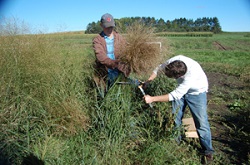 While switchgrass is seen as a good candidate for biofuels, the challenge has been producing it in the quantities of biomass yield to make it worth the effort. But this story from the American Society of Agronomy says researchers with the U.S. Department of Agriculture are looking at ways to make the plant more biofuel friendly.
While switchgrass is seen as a good candidate for biofuels, the challenge has been producing it in the quantities of biomass yield to make it worth the effort. But this story from the American Society of Agronomy says researchers with the U.S. Department of Agriculture are looking at ways to make the plant more biofuel friendly.
[Michael Casler, a research geneticist with the USDA Agricultural Research Service,] and others are trying to [make a better switchgrass for biofuels] by using alternative breeding methods. Zulfi Jahufer is a senior research scientist in genetics and plant breeding at the AgResearch Grasslands Research Centre in Palmerston North in New Zealand, and was a co-researcher with Casler.
But achieving their goals isn’t easy. The ideal switchgrass wouldn’t possess one trait, but many. It would have a high amount of biomass per acre and be able to produce a lot of ethanol. It would also have low levels of lignin, a material found inside plants that prevents maximum ethanol production…
When the ideal plant would contain more than one important trait, it’s inefficient to select for them one at a time. To combat this issue, and breed switchgrass that has the optimal combination of these traits, the researchers tried evaluating plants using the Smith-Hazel Selection Index.
This index allowed the researchers to estimate and combine information on multiple traits. It also looked at the economic value of each trait, which further maximizes the rating.
The researchers say the next step needed to meet their goals is to use the protocols in an actual breeding program. They will begin to employ the best selection indices over the next few generations to obtain a more ideal switchgrass.
This research was recently published in the journal Crop Science.

